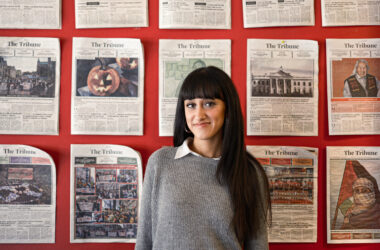The bastard son of the 17th century’s commissioned works and the late 19th century’s photographic revolution, portraits are here to stay. We’ve all had one taken. Graduations. Weddings. Family Reunions. Selfies in the park. Sunday night webcam sessions. Blue Dog Friday night Canon-fests. And the elementary school photo. Throughout primary school, once a year, we were shuffled into the gym or library, one by one, to sit in front of the cameraman. And then with a flash bright enough to make our cheeks and forehead glow, we were immortalized in a wallet print you took home to your parents while they hemmed and hawed over purchasing photo package A or photo package B.
Photographic portraiture seems a strange practice of the 21st century when compared to its lofty origins. Portraits used to be elitist, available only to the wealthy. Depending on your level of affluence, you’d hire a traveling artist or a famous painter to visit your family and freeze you in time with canvas and oil paint. There was always room for artistic interpretation. Of course, a likeness was necessary, but a shadow here and a highlight there were the tools of the trade, drawing attention away from less-flattering aspects of the subject. Portraits got their first big break during the Renaissance, when Leonardo da Vinci painted “Mona Lisa” and Diego Velázquez painted “Las Meninas.” But it was really Vincent van Gogh and Paul Gauguin who paved the way for the ubiquitous self portrait.
The 19th-century invention of the daguerreotype, and later the wet collodion process – both revolutionary steps forward in photography – overhauled the lower echelons of portraiture. Portraits were soon available en masse to the general public through photographic prints. The industry ballooned outward, exponentially expanding with the introduction of the “Brownie,” one of the first inexpensive personal cameras. Portraits became the new hot topic in the artistic world. Black-and-white photography invaded the fashion world and Richard Avedon’s stylistic prints changed our perception of capturing the essence of a person through film.
The invention of the digital camera has changed portraiture and photography forever. Besides the fact that the digital single-lens reflex camera is the hottest new spring accessory, our online world had spurred the reinvention of the portrait. Those school photographers no longer toil in a dark room to develop images of cherubic, infantile cheeks, but spend their afternoons in front of their computer touching up acne spots and shiny foreheads with Photoshop. The price of a respectable digital camera has been cut in half in the last couple years, flooding the market with affordable choices for budding photographers. Today, we take a picture, manipulate it, and then post it for the world to see – perhaps as our Facebook or MySpace profile picture. Technology has given us the ability to choose how we depict ourselves. Our photographic histories are written instantaneously.
In the end, portraits have come full circle. Photography may have replaced painting as the choice method of remembrance for society’s upper tier, but professional work still comes with a weighty price tag. Martin Schoeller has made a name for himself through his portraiture work. His subjects spend 10 minutes in a white box-like structure with thousands of watts of light beaming onto them. With a click, Schoeller captures a signature white-light reflection on his subject’s iris. He has worked with everyone from Jack Nicholson to Heidi and Spencer (“Speidi”) Pratt.
It’s difficult to have a night out without it being captured on someone’s memory stick. Those who love to capture people on film are competing against every artistically inclined camera owner. Sure, your mom tells you they’re good, but when your index finger plunges down on the shutter button or your laptop-embedded webcam snaps a shot, what are you really thinking about? Do you really need another picture of yourself? Maybe you’re just projecting yet another interpretation of yourself – a little different from the one before – into the digital universe.








